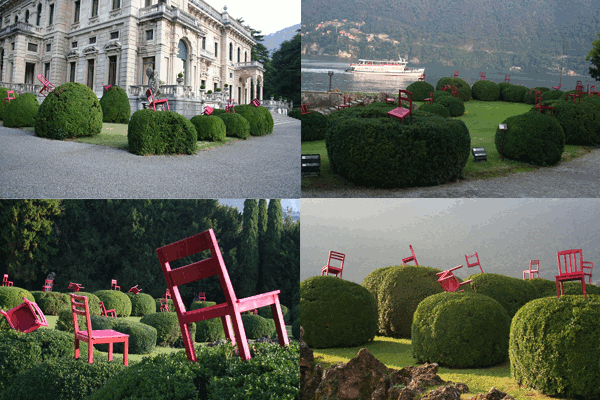 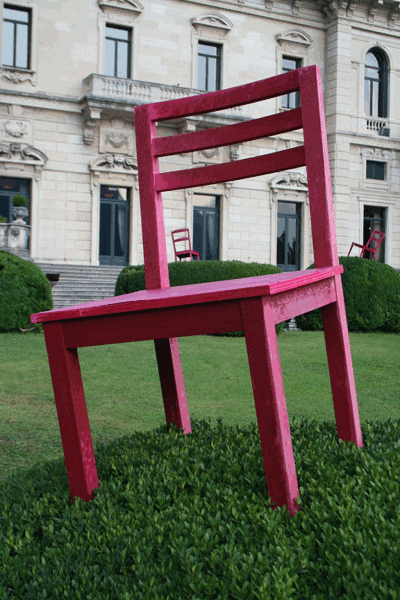 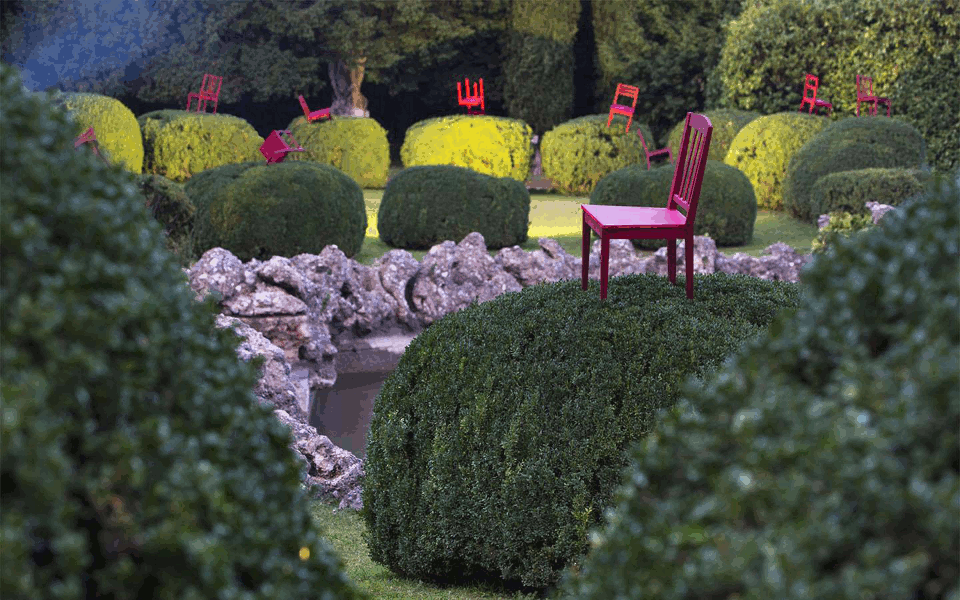 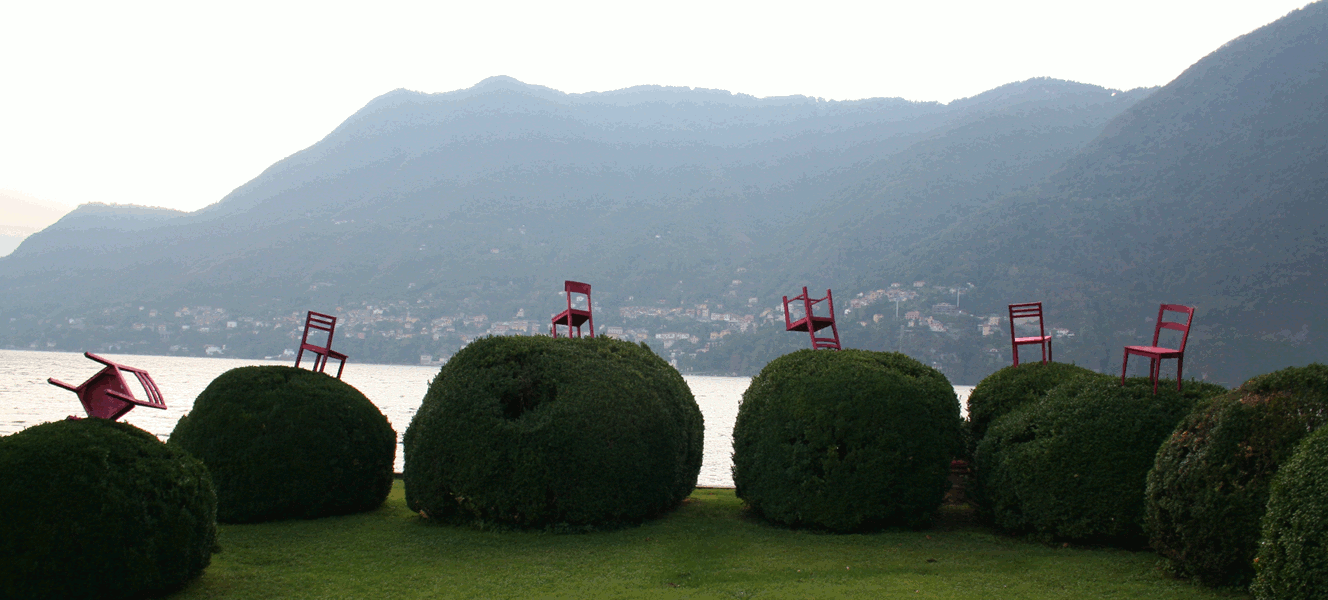
Dove sei ? Where are you ?, 2012
Wooden painted chairs
Temporary installation for the exhibition "Orticolario"
Installation éphémère pendant l'exposition "Orticolario"
Villa Erba, Lac de Come, Italie

|
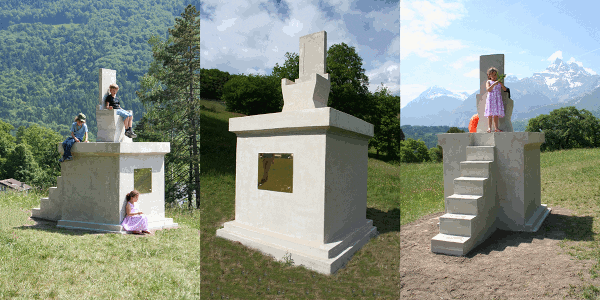
Monument, 2011
Ciment and plate of coper (Béton plaque de cuivre)
The visitors of the exhibition could send their picture on a Web site ; http://www.bexarts.ch/2011/monument
Les visiteurs de l'expositions étaient invités à envoyer leurs photos sur un site internet. Voire: http://www.bexarts.ch/2011/monument
Bex “ Territoires " 11ème triennale de sculpture Suisse contemporaine, Bex-Art.

|
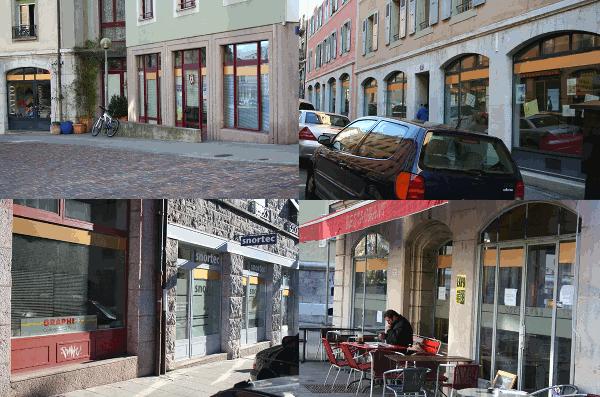
Le Lien, 2010
Installed during the Christmas holidays, a golden line crosses and links the district of « Les Grottes » in Geneva
Installée pendant les fêtes de Noël, une ligne dorée traverse et lie le quartier des Grottes à Genève

|
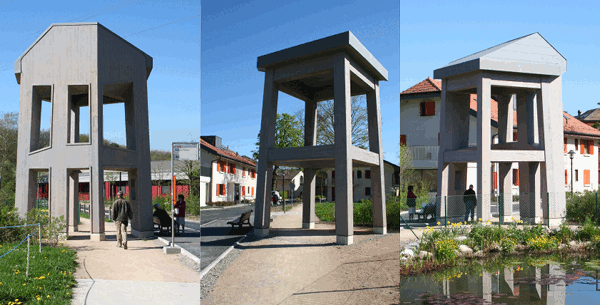
Le Tabouret, 2009
8000 cm
Wood, concret, zinc (Bois, ciment, zinc)
This sculpture "anamorphic", also used as a bus stop, is located in the village center of " Aigues-Verte Foundation ". This village was created in 1961 for people with mental disabilities. Those people are the villagers, they have a place to live and a job suited to their differences.
The social and economic integration of people with intellectual disabilities has remained an essential value of this institutional project.
Cette sculpture "anamorphique", également arrêt de bus, est située au centre du village de La Fondation Aigues-Vertes. Ce village a été créé en 1961 pour des personnes souffrant d’un handicap mental. Ces personnes, mentalement handicapées, sont les villageois avec un lieu de vie et un travail adaptés à leurs différences.
L'intégration sociale et économique des personnes déficientes intellectuelles est restée une valeur incontournable de ce projet institutionnel.
Village de Aigue Verte, Geneva, Switzerland

|
 
Dos à Dos, 2008
500 cm
Ciment,ceramic, wood (Ciment, ceramic, bois)
Bex «Lascia mi » 10ème triennale de sculpture Suisse contemporaine, Bex-Art.

|
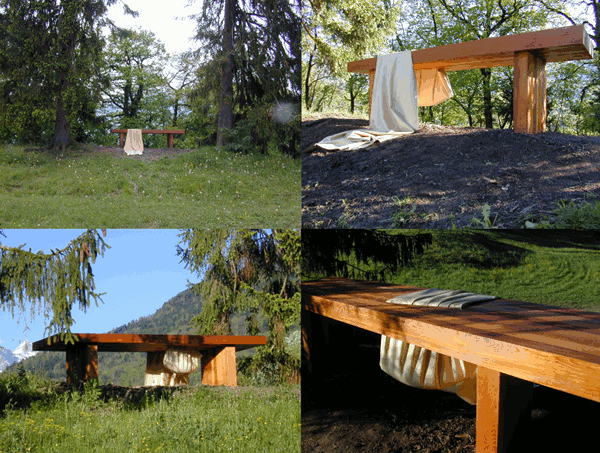
Promesses, 2002
90 x 310 x 75 cm
Wood, latex (Bois, latex)
Bex " Noces " 8e triennale de sculpture Suisse contemporaine, Bex-Art

|
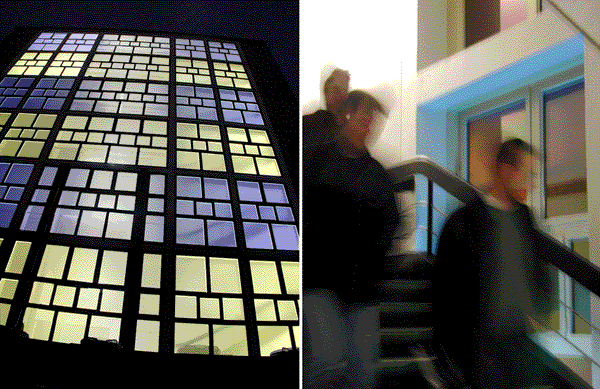
ERAG light installatio, 2001
Lighting (lumière)
The urban cities are living life organisms that change, transform and evolve over time. The Sévelin Valley in Lausanne, lives on such transformations. The fundamental assessment of my framework reflects these changes and does not seek, in any way shape or form, to heavily force itself upon the area.
The idea is to perceive the building thru' a colorful nocturnal lighting, emanating from within the two sprockets situated on the northern and the southern sides of the building.
At dusk, the colored lighting is turned on. It encompasses the entire height of the exterior facades, covering each floor, alternating between the colors blue and yellow.
-This colored luminescence can be observed as an outer descriptive element within the urban area of the Sévelin Valley.
As early as sundown, both the heavily frequented recreational space, located at the extremities of each floor, and the surroundings outside the building, benefit
from this soothing and serene lighting.
-In the cities, people tend to circulate and are therefore, constantly in motion. It is precisely within this movement that the building's nocturnal lighting manifests itself in all its splendor and reveals itself fully.
-The lights are secured to the floor, in the center of each window frame. They are inherent to the geometry and to the aesthetics of the building. This translucent screen of colored lighting creates a "silhouette" effect, emphasizing the constructive structure of the building.
Les villes sont des organismes vivants qui changent, se transforment et évoluent dans le temps. La Vallée de Sévelin à Lausanne, est amenée à vivre ces changements. Les bases de réflexion de mon installation tiennent compte de ces changements et ne cherchent en aucun cas à s’imposer lourdement dans le quartier.
Il s’agit de redonner à voir le bâtiment à travers un éclairage nocturne et coloré, disposé à l’intérieur des deux pignons Nord et Sud du bâtiment.
Dès la tombée du jour, l’éclairage coloré est allumé. Il couvre toute la hauteur des façades, en alternance bleu-jaune à chaque étage.
Cet éclairage coloré peut être envisagé comme un élément de signalétique extérieur dans l’espace urbain de la Vallée de Sévelin.
L’espace récréatif situé aux extrémités de chaque étage, abondamment fréquentées par les étudiants, ainsi que l’environnement extérieur au bâtiment, bénéficie également de cette douce lumière, dès la tombée du jour.
Dans la ville, les gens circulent et se déplacent constamment, c’est bien dans ce mouvement que l’éclairage nocturne du bâtiment s’inscrit et se révèle.
Les luminaires sont fixés au sol, au centre de chaque cadre de fenêtre. Ils s’inscrivent dans la géométrie et l’esthétique du bâtiment. Ce rideau transparent de lumière colorée crée un effet « silhouette » et souligne la structure constructive du bâtiment.
ERAG Lausanne

|
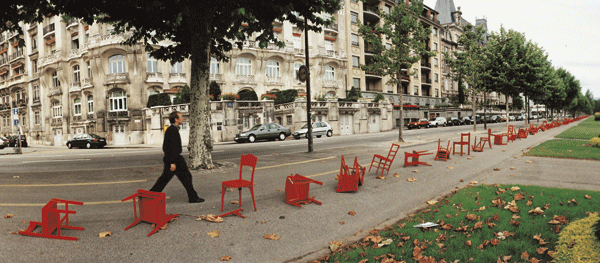  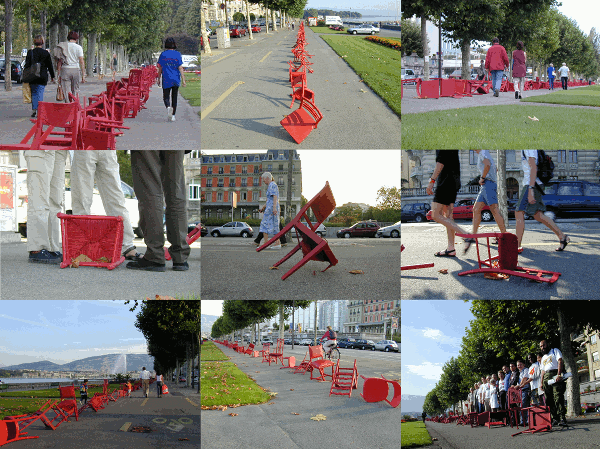 
Ligne Rouge (Red line), 2000
Painted wooden chairs (Chaises peintes)
Hosted by Switzerland, the second Annual Meeting of Member States Parties to the Convention on the Prohibition of Anti-Personnel Landmines took place at the “Palais des Nations Unies” (United Nations assembly room) from September 11th to September 15th 2000, in Geneva. The title of the conference is “Every minute counts”
Following the construction of the sculpture entitled “Broken Chair” which was displayed in 1997 at the United Nations Plaza, in the same city, project “Ligne Rouge” (Red line) appealed to the symbolism and metaphor represented in “Broken Chair”, as a grim reminder of the tragic passage of time, where a landmine produces a victim every 20 minutes.
During the entire length of the convention, a chair, inititially painted in red, was placed in line every 20 minutes, throughout a 24 hours timespan, in order to create a steady and continuous red line along the Quai Wilson boulevard (located across from the Wilson Palace, central office of the High Commissioner for Human Rights).
Du 11 au 15 septembre 2000, la deuxième réunion annuelle des Etats participant à la Convention d'interdiction des mines antipersonnel s'est tenue au Palais des Nations-Unies à Genève. La Suisse fut l'hôte de cette conférence. Le titre de la conférence est « Chaque minute compte »
Faisant suite à la sculpture Broken Chair posée sur la place des Nations à Genève en 1997, le projet Ligne Rouge a décliné le symbole que représente aujourd'hui la chaise brisée pour mieux rappeler cette cadence de temps tragique : une victime toutes les 20 minutes.
Pendant toute la durée de la conférence, une chaise, préalablement peinte en rouge, a été posée toutes les 20 minutes, 24 heures sur 24, pour former une ligne continue le long de la promenade du Quai Wilson (en face du Palais Wilson, siège du Haut-Commissariat aux Droits de l’Homme).
Installation/Performance in Geneva Durind the Second Annuel Meeting of Member State Parties to the Convention on the Prohibition of Anti-Personnel Landsmines.

|
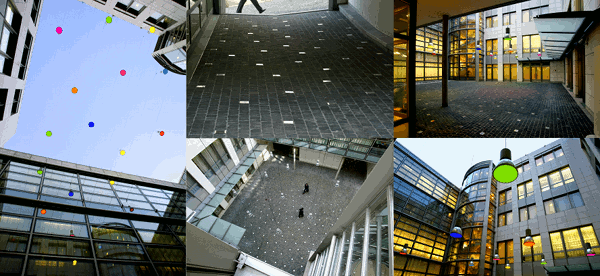
La cour, 2000
Pavement ground and lighting (Pavage et éclairage de la cour)
With Carmen Perrin
Instalation réalisée avec Carmen Perrin
UBS, Lausanne, Switzerland

|

Caroline, 1999
215 cm
Wooden chair under an apple tree (Chaise en bois sous un pommier)
Bex « Mémoires, paysages intérieurs » 7e triennale de sculpture Suisse contemporaine

|
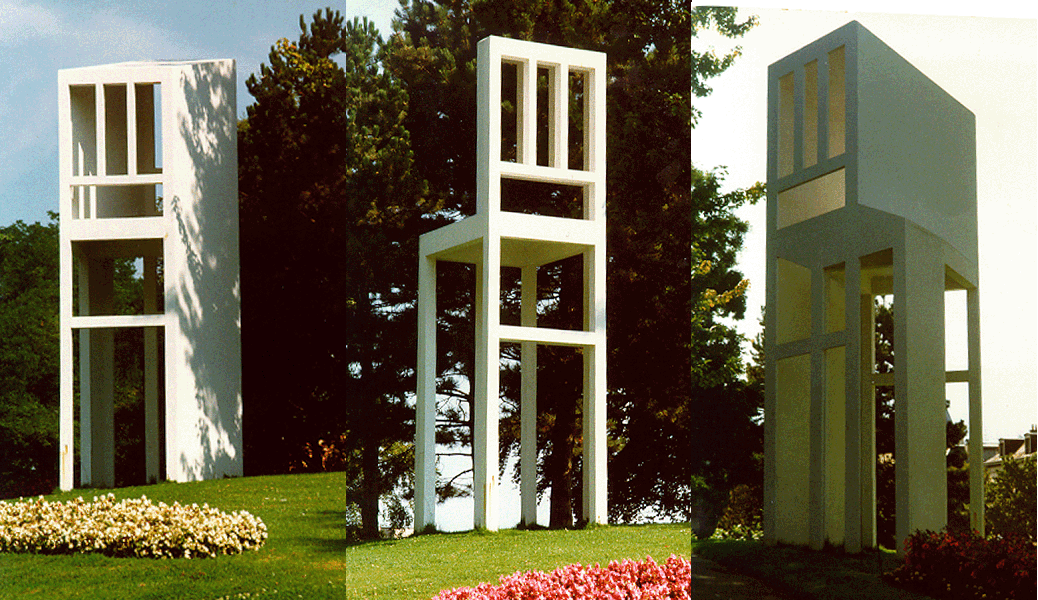
Regard MAH (Projection 2), 1997
750 cm
Wood, painting. (Bois, peinture.)
« The Stare »
This exhibition, whose main theme is "The Stare" responds to an invitation from Claire Stoulig at the Museum of Art and History of Geneva.
Room 1: Text on painted mirror "Art teaches us nothing about life, rather about who looks at it." . Walls covered with gray stickers
Room 2: anamorphic charcoal drawing’s animals on the wall
Exterior Museum: "Projection" wooden anamorphic sculpture. Height: 750cm
A book has been published in this regard: "The Stare ll" "There once was an imaginary museum" text written by Claire Stoulig.
This is a personal pilgrimage and journey through Art History, based on a concept by André Malraux, in his writings "The voices of silence"
Cette exposition, dont le thème est « Regard » répond a une invitation de Claire Stoulig au Musée d’Art d’Histoire de Genève.
Salle 1: Texte sur miroir peint « L’art ne nous apprend rien sur la vie mais sur celui qui regarde ». Murs recouvert d’autocollant gris
Salle 2: Dessins d’anamorphoses au fusain sur les murs
Extérieur Musée : « Projection » sculpture anamorphique en bois. Hauteur de 750cm
A cette occasion, un livre a été réalisé : Regard ll « Il était une fois un musée imaginaire » texte de Claire Stoulig.
Il s’agit d’un voyage personnel à travers l’histoire de l’art, basé sur un concept de André Malraux dans « Les vois du silence »
Devant le Musée d'art et d'Histoire de Genève

|

Regard MAH (chambre au miroir), 1997
« The Stare »
This exhibition, whose main theme is "The Stare" responds to an invitation from Claire Stoulig at the Museum of Art and History of Geneva.
Room 1: Text on painted mirror "Art teaches us nothing about life, rather about who looks at it." . Walls covered with gray stickers
Room 2: anamorphic charcoal drawing’s animals on the wall
Exterior Museum: "Projection" wooden anamorphic sculpture. Height: 750cm
A book has been published in this regard: "The Stare ll" "There once was an imaginary museum" text written by Claire Stoulig.
This is a personal pilgrimage and journey through Art History, based on a concept by André Malraux, in his writings "The voices of silence"
Cette exposition, dont le thème est « Regard » répond a une invitation de Claire Stoulig au Musée d’Art d’Histoire de Genève.
Salle 1: Texte sur miroir peint « L’art ne nous apprend rien sur la vie mais sur celui qui regarde ». Murs recouvert d’autocollant gris
Salle 2: Dessins d’anamorphoses au fusain sur les murs
Extérieur Musée : « Projection » sculpture anamorphique en bois. Hauteur de 750cm
A cette occasion, un livre a été réalisé : Regard ll « Il était une fois un musée imaginaire » texte de Claire Stoulig.
Il s’agit d’un voyage personnel à travers l’histoire de l’art, basé sur un concept de André Malraux dans « Les vois du silence »

|
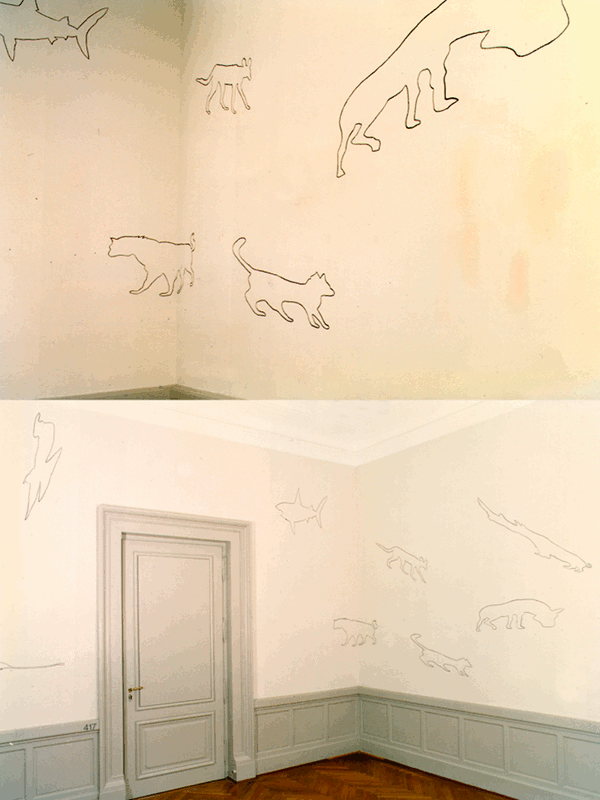
Regard MAH (Anamorphoses), 1997
« The Stare »
This exhibition, whose main theme is "The Stare" responds to an invitation from Claire Stoulig at the Museum of Art and History of Geneva.
Room 1: Text on painted mirror "Art teaches us nothing about life, rather about who looks at it." . Walls covered with gray stickers
Room 2: anamorphic charcoal drawing’s animals on the wall
Exterior Museum: "Projection" wooden anamorphic sculpture. Height: 750cm
A book has been published in this regard: "The Stare ll" "There once was an imaginary museum" text written by Claire Stoulig.
This is a personal pilgrimage and journey through Art History, based on a concept by André Malraux, in his writings "The voices of silence"
Cette exposition, dont le thème est « Regard » répond a une invitation de Claire Stoulig au Musée d’Art d’Histoire de Genève.
Salle 1: Texte sur miroir peint « L’art ne nous apprend rien sur la vie mais sur celui qui regarde ». Murs recouvert d’autocollant gris
Salle 2: Dessins d’anamorphoses au fusain sur les murs
Extérieur Musée : « Projection » sculpture anamorphique en bois. Hauteur de 750cm
A cette occasion, un livre a été réalisé : Regard ll « Il était une fois un musée imaginaire » texte de Claire Stoulig.
Il s’agit d’un voyage personnel à travers l’histoire de l’art, basé sur un concept de André Malraux dans « Les vois du silence »

|

La ferme, 1997
300 cm
Painted metal (Métal peint)
Meyrin, Geneva, Switzerland
Meyrin, Genève, Suisse

|
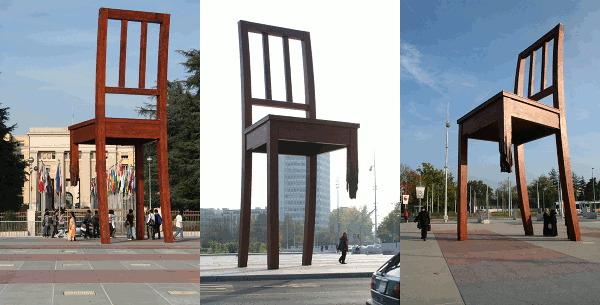
Broken Chair, 1997
1200 cm
Wood (Bois)
This sculpture was first showcased on August 18th
1997, at the United Nations Plaza in Geneva, in association with Handicap International, to summon all countries to sign the Anti-Personnel Landmine Ban Treaty and to honor their promises in giving their full support to landmine victims and to undertake all actions to clear out landmine territories.
Following the setup and configuration at the United Nations Plaza, “Broken Chair” was displayed once again on February 26th, 2007, to invite all countries to participate in the ban against cluster munitions, a process initiated in Oslo on February 23rd, 2007.
Sculpture réalisée le 18 août 1997 sur la Place des Nations à Genève en collaboration avec Handicap International pour appeler tous les Etats à signer la Convention des mines antipersonnel et à tenir leurs engagements à assister les victimes et à déminer les territoires pollués.
Suite à l’aménagement de la Place des Nations, Broken Chair est réinstallée le 26 février 2007 pour inviter les Etats à participer à l’interdiction des armes à sous-munitions, processus initié à Oslo le 23 février 2007.
Place des Nations Unies, Geneva, Switzerland

|
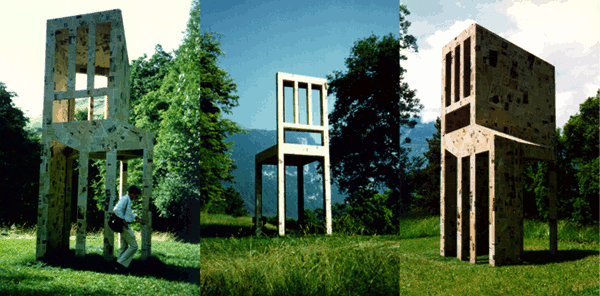
Projection, 1996
5750 cm
Wood cover with international newspapers (Bois recouvert de journaux internationaux)
Bex&Art "Babylon, a hanging garden" 6th Triennial of Contemporary Swiss sculpture.
What you see or what is ?
This in situ installation refers to my research, which i started in 1982 with the creation of the sculpture "The Stool", on the perception and the point of view of the observer.
In « Projection » depanding on point of view amongs a set of various forms a chair becomes visible
Ce que tu vois ou ce qui est ?
Cette installation in situ fait suite à ma recherche, commencée en 1982 avec la sculpture "The stool", sur la perception et le point de vue du spectateur.
Dans « Projection » parmis un ensemble de forme apparaît suivant l’angle de vue une chaise.
BEX « Babylone, un jardin suspendu » 6e triennale de sculpture Suisse contemporaine, Bex-Art.

|

La Quadrature du cercle, 1995
240 x 240 x 240 cm
Wood (Bois)
« The Squared Circle »
Winner of an international competition, I have created this piece in situ for the new administrative center of the “Credit Suisse” bank, located in Zurich.
It is in 1983, that I started my research on the subjectivity of point of views and three dimensional anamorphosis.
The « Quadrature du cercle » (The Squared Circle), made out of wood and suspended from the ceiling by 4 lead wires each 5 mm in width, illustrates this complexity and is reflected within the space of a 230 square cm figure.
Depending on the angle and point of view, the viewer can discern various shapes and forms. Among all this forms the viewer can also identify : a zero/circle, a sign of the infinite and a heart. I found these three different shapes to be most relevant and pertinent for the bank's entrance hall.
Lauréat d’un concours international sur invitation, j’ai réalisé cette sculpture in situ pour le nouveau Centre administratif de la banque du Crédit Suisse à Zurich.
C’est en 1983 que j’ai commencé ma recherche sur la subjectivité du point de vue et les anamorphoses en trois dimensions. La Quadrature du cercle reprend cette problématique et s’inscrit dans l’espace d’un carré de 230 cm de côté. Construite en bois, elle est accrochée au plafond par 4 câbles en acier de 5 mm.
Selon différents points de vue, elle nous permet notamment de voir : un zéro/cercle, le signe de l’infini et un coeur.
Ces 3 formes me semblaient particulièrement adéquats pour le hall d’entrée de la banque.
Crédit Suisse, Zürich, Switzerland

|
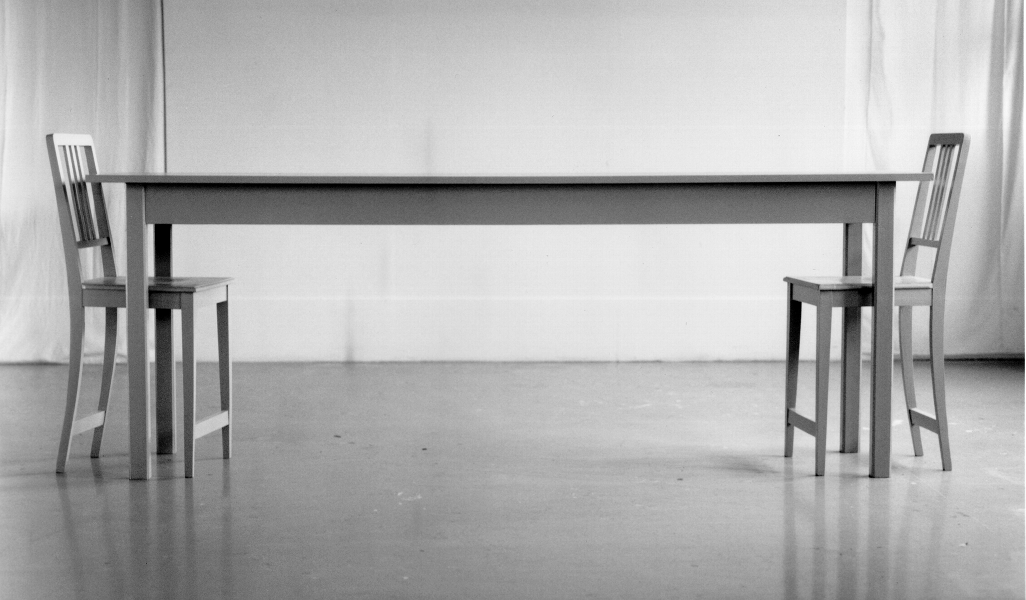
Vis à Vis, 1994
120 x 300 x 46 cm
Wood (Bois)
Both the chairs and the table are elevated, thus preventing the seated subject’s legs from touching the ground.
Les deux chaises ainsi que la table sont légèrement surélevées et ne nous permettent pas, quand on s’assied, de poser les pieds au sol
Musée Arlaud Lausanne – Arlaud Museum Lausanne

|
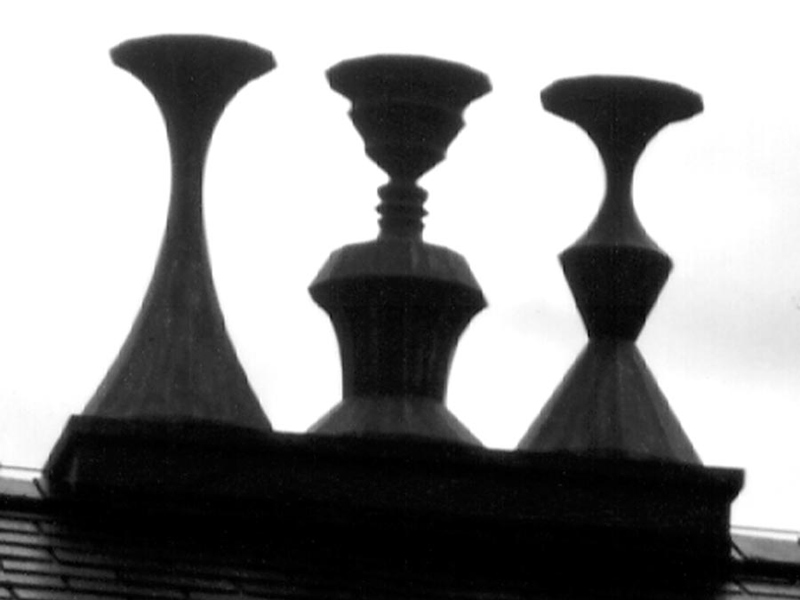 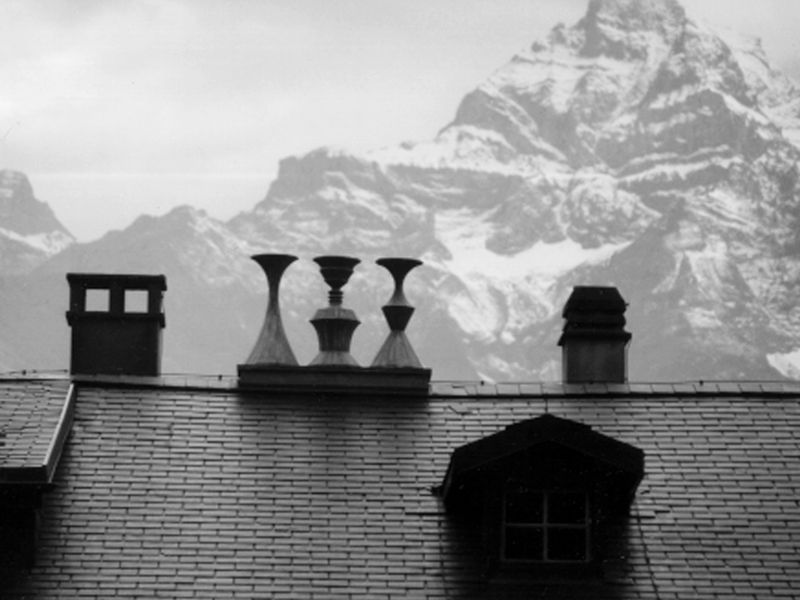
Le Baiser (The Kiss), 1993
140 cm
Epoxy, wood (Epoxy, bois)
« The Kiss ».
The Bex&Art triennial of Swiss sculptures, organized by Nicolas Raboud, is located in a magnificent park where artists are invited to present their works.
Generated from my studio work, “Le Baiser de Bex” (The Kiss of Bex) is composed of three elements in which two faces appear within the empty space created in between them. Although both profiles made out of the object in the center are identical, my intention was to draw out two different outer profiles creation the illusion of a man and a woman’s features. I placed “Le Baiser de Bex” on the roof of a house located at the entrance of the park where the exhibition took place. In order to discreetly integrate this sculpture within its surroundings, both color and size of “Le Baiser de Bex” refer to the existing chimneys on the roof.
La triennale de sculpture suisse Bex&Art, organisée par Nicolas Raboud, se situe dans un parc magnifique dans lequel les artistes sont invités présenter leur oeuvre.
Issu de mon travail d’atelier, Le baiser est constitué de trois éléments dans lesquels s’inscrivent dans le vide deux visages. Bien que les deux profiles définis par l’objet du centre soient identiques, mon étude consistait à dessiner deux profiles extérieurs différents afin de suggérer que les deux visages représentent un homme et une femme. J’ai installé le baiser sur le toit de la maison située à l’entrée du parc. Pour l’intégrer discrètement, la couleur et la taille du baiser de Bex se réfère aux cheminées déjà présentes sur le toit.
Bex « Mise en scène » 5ème triennale de sculpture Suisse contemporaine Bex-Art.

|
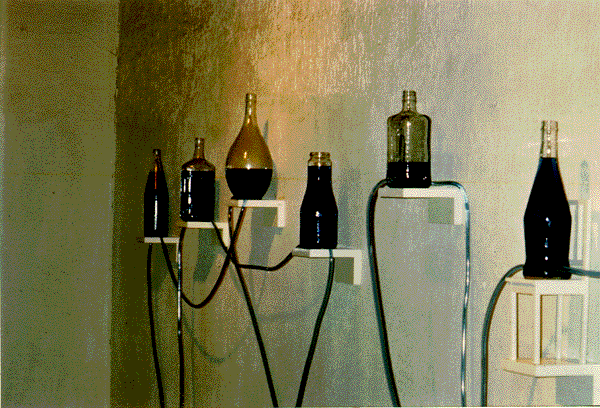 
La ou rien ne se passe, 1993
glass, colored water, PVC pipes (verre,eau colorée, pvc tuyaux)
Galerie Linder Basel

|
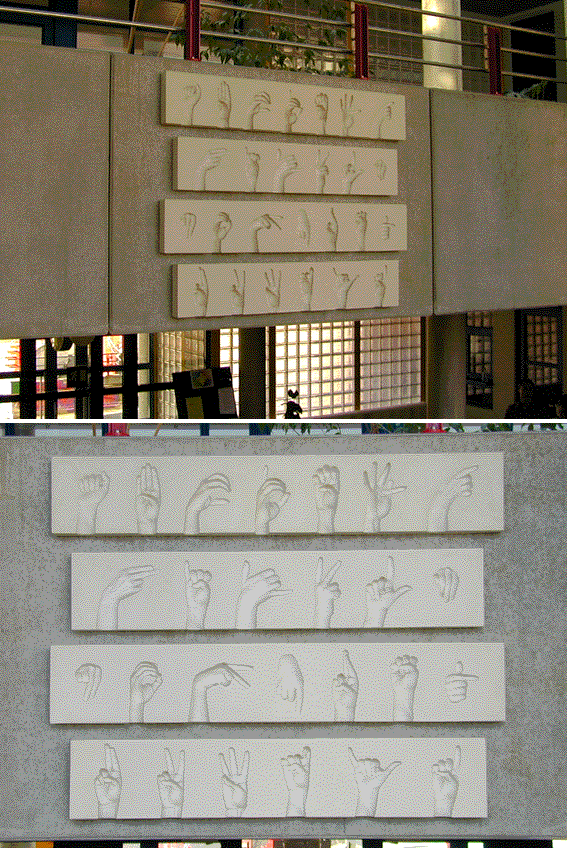
Alphabet (Les Cinq Sens) , 1993
cement molding (moulage en ciment)
Ecole primaire de Cazla Geneve

|
 
Toucher (Les Cinq Sens) , 1993
cement molding (moulage en ciment)
Ecole primaire de Kayla Geneve

|

Gouter (Les Cinq Sens) , 1993
cement molding (moulage en ciment)
Ecole primaire de Kayla Geneve

|

Sentir (Les Cinq Sens) , 1993
cement molding (moulage en ciment)
Ecole primaire de Kayla Geneve

|

Entendre (Les Cinq Sens) , 1993
cement molding (moulage en ciment)
Ecole primaire de Kayla Geneve

|

Voir (Les Cinq Sens) , 1993
cement molding (moulage en ciment)
Ecole primaire de Kayla Geneve

|
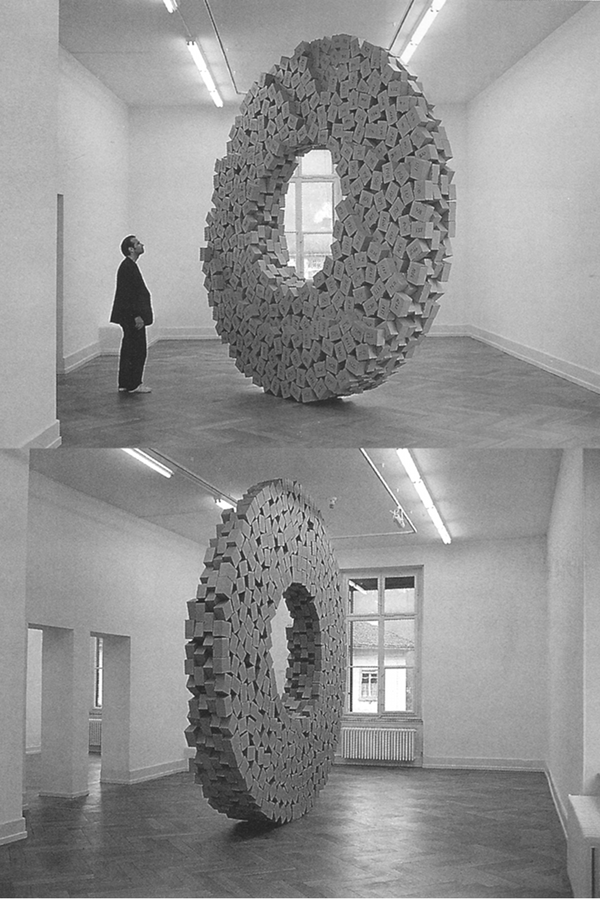 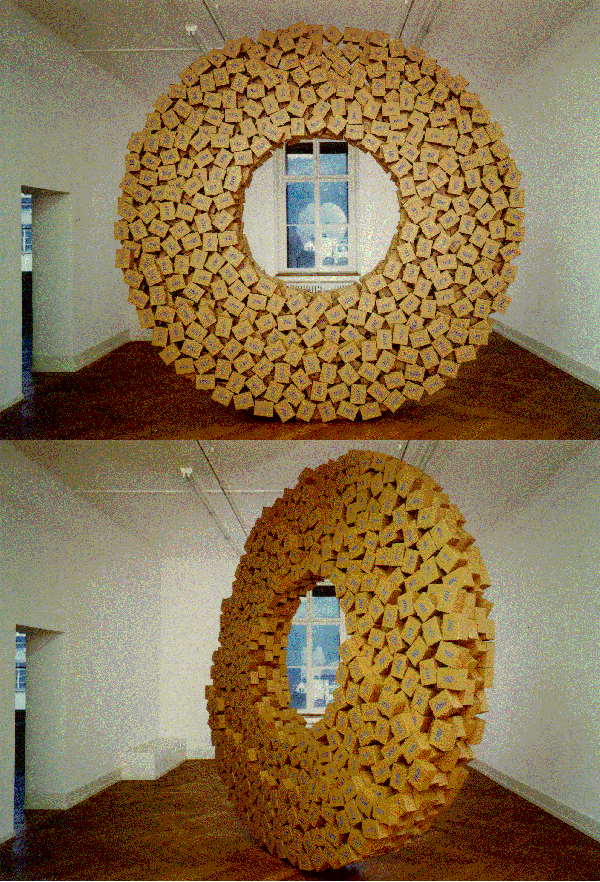
La roue, 1992
400 cm
1257 cardboard boxe numbered (1257 boîtes en carton numérotées)
«The Wheel».This in situ installation (the Wheel was created in the Kunsthalle Palazzo in Liestal.
The site of the Kunsthalle, located on the dock of the Liestal train station, was used in the earlier period as a storage area for dispatched mail.
Within the entire height of this given space, I built a wheel consisting of 1257 cardboard boxes, originally used by the Post office. In order to convey and indicate fleeting time, each cardboard box carries a number assigned to it during assembly.
Cette installation in situ a été réalisée au Kunsthalle Palazzo à Liestal.
L’espace de cette Kunsthalle, située sur le quai de gare de Liestal, servait autrefois de centre de triage de la Poste.
Constituée de 1257 boîtes en carton utilisées par la Poste, J’ai construit cette roue dans toute la hauteur de l’espace
Pour marquer le passage du temps, chaque boîte en carton a été numérotée lors de la construction.
Installation in situ Kunsthalle Palazzo Bâles
Ancien bâtiment gare et post office

|
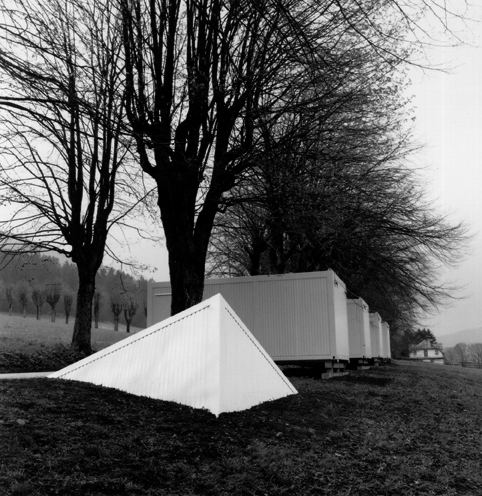
Container 1/x, 1991
300 x 600 x 600 cm
construction container (conteneur de chantier)
I was invited to participate in the “Ex Aequo” exhibition organized for the 700th Anniversary of the Swiss Confederation.
Located in the district of St-Imier, along a path surrounded by trees, 26 sheds – corresponding to the 26 Swiss counties, - were submitted to 26 artists.
The artists were encouraged to work inside these small tool sheds, each built with a door and a window, whose dimensions were: 600x300x300 cm.
I chose to work on the idea and concept of two model icons representing Swiss identity: bank secrecy and mountain sceneries and landscapes.
Deciding not to present my work within the limits and restraints of the shed, I settled to use the shed itself as an object.
As is the case with an iceberg, I buried 9/10th of the shed and have selected to only show the tip of it at a particular angle, suggesting the outline of a mountain range.
J’ai été invité à participer à l’exposition « Ex æquo » à l’occasion du 700ème anniversaire de la Confédération suisse.
Situé sur le site de St-Imier, le long d’un sentier bordé d’arbres, 26 conteneurs - le nombre des cantons suisses - ont été mis à la disposition d’autant d’artistes. Ceux-ci étaient invités à travailler à l’intérieur de ces conteneurs de chantier, disposant d’une porte et d’une fenêtre et mesurant 600x300x300 cm.
J’ai décidé de jouer sur deux clichés à propos de l’identité suisse : le secret bancaire et l’image de ses montagnes.
Refusant de disposer mon œuvre à l’intérieur du conteneur, j’ai pris celui-ci comme un objet dans son ensemble.
Tel un iceberg, j’ai enterré les 9/10èmes de ce conteneur et laissé apparaître un angle de celui-ci afin de suggérer la silhouette des montagnes
St Imier Exposition « Ex-Aequo » 700e anniversaire de la confédération suisse

|

La vague SIP, 1990
280 cm
Wooden pavement (Pavés de sol en bois)
« The Wave SIP»
(SIP) Sous d’Innombrables Pavés - Under countless cobblestones.
This in situ installation was created at the SIP factory, in the city of Geneva (Switzerland), just before the MAMCO (the museum of modern and contemporary art), was established.
In order to emphasize the transformation of space, I chose to create an upward movement of the land, built from existing wooden cobblestones which in turn evolves into a wave shaped form and figure.
The initial spot where the wooden stones used to lay is replaced by a layer of metal slices which were found within the same area.
Cette installation in situ a été réalisée dans l’espace industriel de la SIP à Genève, juste avant que le Musée d’Art Moderne et Contemporain (MAMCO) s’installe dans ce lieu.
Afin de marquer le changement d’affectation de l’espace, j’ai décidé de faire glisser le sol, constitué de pavés en bois, pour donner naissance d’une vague.
L’espace au sol libéré de ses pavés a été remplacé par une couche de copeaux de métal récupérés sur le site.
Genève

|
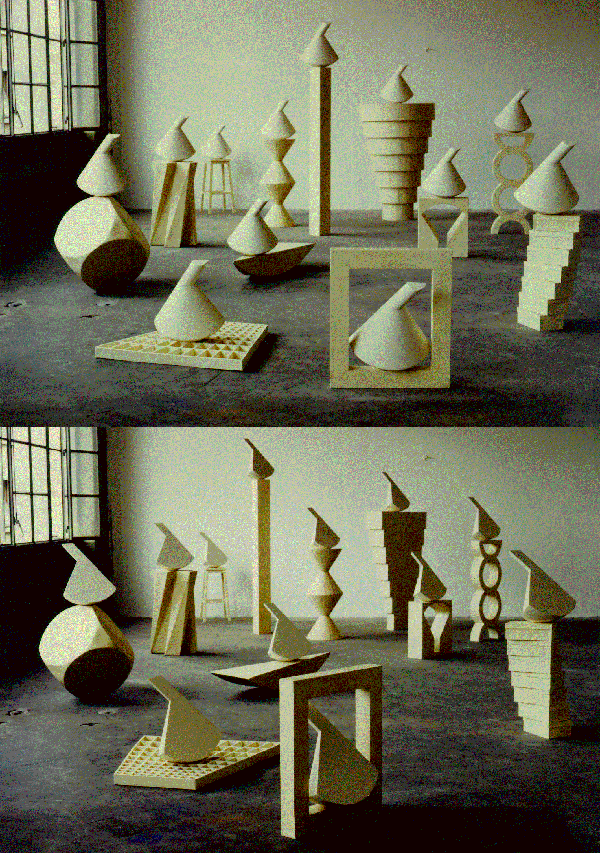
Mae de Agua, 1990
400 cm
12 plastic pieces on cardboard base (12 pièces en plastique sur socle en carton)
Can a pedestal change the perception of the object it is supporting?
“Mae de Agua”, meaning “the Mother of all Waters” in portuguese, is the name given to the first water tower which was built in Lisbon and used to supply all of the city’s fountains.
It is from the original shape of a hosepipe that I have drawn the object standing on twelve pedestals.
For the exhibition entitled “Transformation” organized by Pro Helvetia, I have represented 12 sculptures on pedestals inside the museum and in parallel, have placed 12 identical objects on the
Le socle peut-il changer la perception de l’objet qu’il supporte ?
Mae de Agua, qui signifie la mère des eaux, est le nom de la première tour d’eau construite à Lisbonne et qui, en son temps, servait à alimenter les fontaines de la ville.
C’est à partir de la forme d’une pomme d’arrosoir que j’ai dessiné l’objet posé sur les 12 socles.
Pour l’exposition organisée par Pro Helvetia, j’ai disposé les 12 sculptures sur socle à l’intérieur du Musée et installé 12 objets identiques sur le bassin du jardin de la Fondation. (voir Mae de Agua H2O)
Fondation Gulbenkiian Lisbonne

|
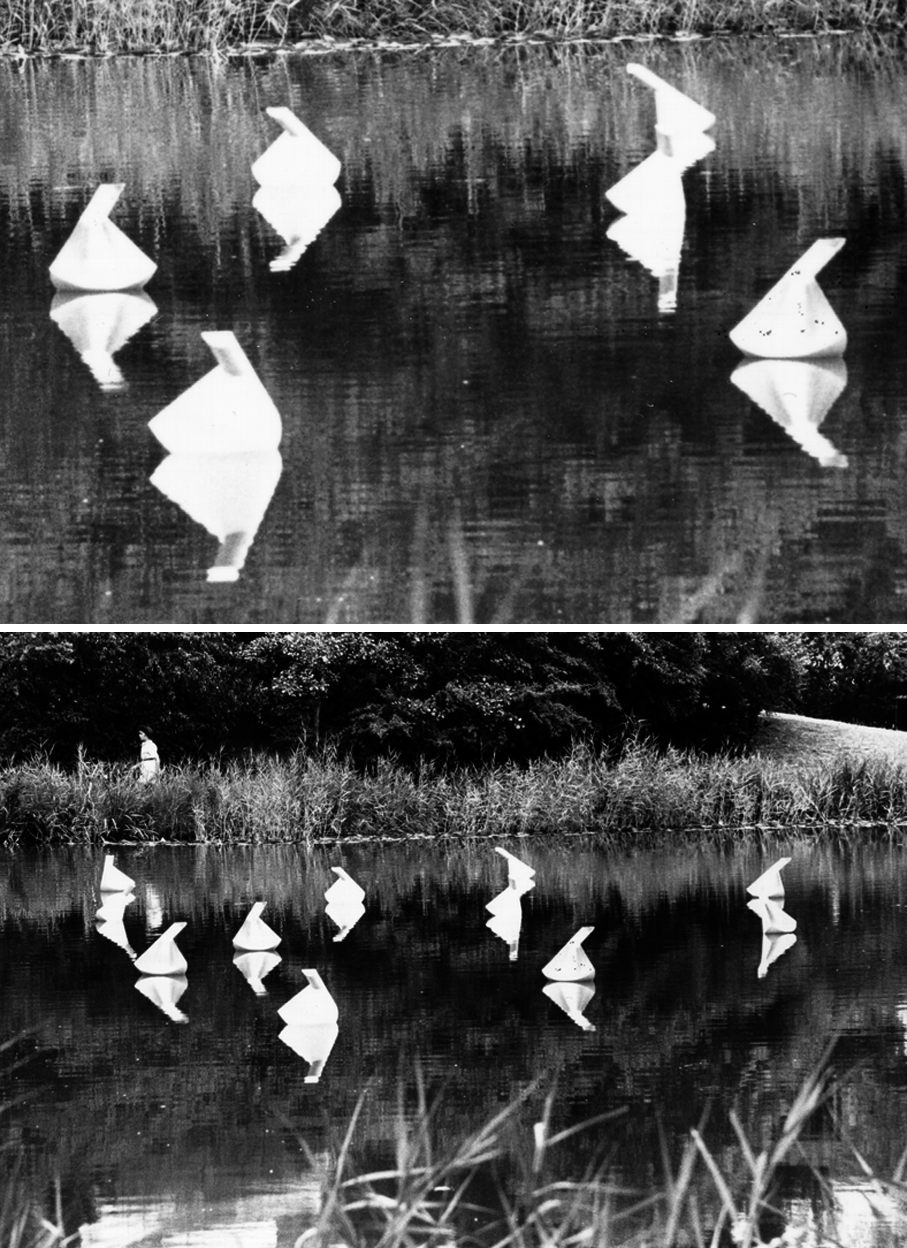
Mae de Agua Eau, 1990
Plastic (Plastique)
Can a pedestal change the perception of the object it is supporting?
“Mae de Agua”, meaning “the Mother of all Waters” in portuguese, is the name given to the first water tower which was built in Lisbon and used to supply all of the city’s fountains.
It is from the original shape of a hosepipe that I have drawn the object standing on twelve pedestals.
For the exhibition entitled “Transformation” organized by Pro Helvetia, I have represented 12 sculptures on pedestals inside the museum and in parallel, have placed 12 identical objects on the
Le socle peut-il changer la perception de l’objet qu’il supporte ?
Mae de Agua, qui signifie la mère des eaux, est le nom de la première tour d’eau construite à Lisbonne et qui, en son temps, servait à alimenter les fontaines de la ville.
C’est à partir de la forme d’une pomme d’arrosoir que j’ai dessiné l’objet posé sur les 12 socles.
Pour l’exposition organisée par Pro Helvetia, j’ai disposé les 12 sculptures sur socle à l’intérieur du Musée et installé 12 objets identiques sur le bassin du jardin de la Fondation. (voir Mae de Agua H2O)
Installation on the pounds in the garden of the Gulbenkian Foundation. Lisboa,Portugal

|

Le Cube, 1989
140 x 140 x 140 cm
Earth (Terre)
"The Cube".
This is the first open-air sculpture I have produced.
My method and approach were the following:
1. It is a cube entirely built out of the earth which was extracted from the area where it was constructed and created.
2. The construction site is selected based upon the characteristics of its soil.
3. The amount of soil extracted representing the silo around the cube will be identical to the amount of soil used in mounting the cube.
4. The anticipated result is that the original shape of the cube should evolve with the changing climate and the passage of time, in order to progressively and swiftly return to its origins, this through a process of natural wear and tear.
Il s’agit de la première Oeuvre que j’ai réalisée l’extérieur.
J’en ai défini le concept suivant :
Il s’agit d’un cube constitué uniquement de la terre prélevée sur le lieu de sa construction.
Le choix de ce lieu sera déterminé selon la nature de son sol.
La quantité de terre extraite, formant le puits autour du cube, sera la même que celle utilisée pour son élévation.
4. Il serait souhaitable que la forme originale de ce cube soit modelée par les intempéries et le passage du temps pour s’en retourner graduellement ou précipitamment en son lieu d’origine suivant en cela l’érosion naturelle.
Môtiers, Switzerland

|

Around a clock, 1985
30 cm
Cardboard, plaster (Carton plâtre)
12 three-dimensional sculpture of the flat shadow of a chair
12 sculpture en trois dimensions de l'ombre portée plate d'une chaise

|

Around the Chair, 1984
Carton.lumière

|

The black Shadow, 1984
Cardboard, light (Carton, lumière)

|
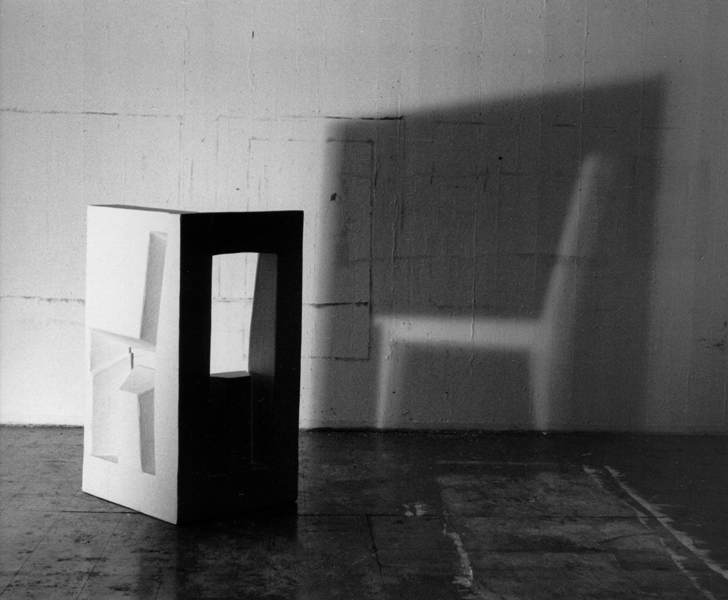
The white Shadow, 1984
Cardboard, light (Carton, lumière)

|